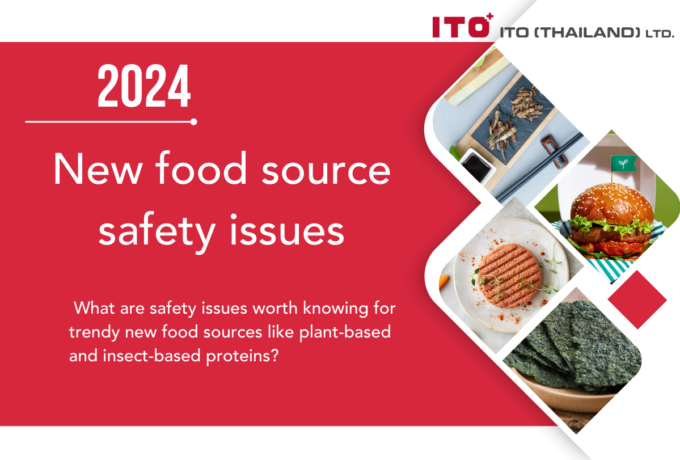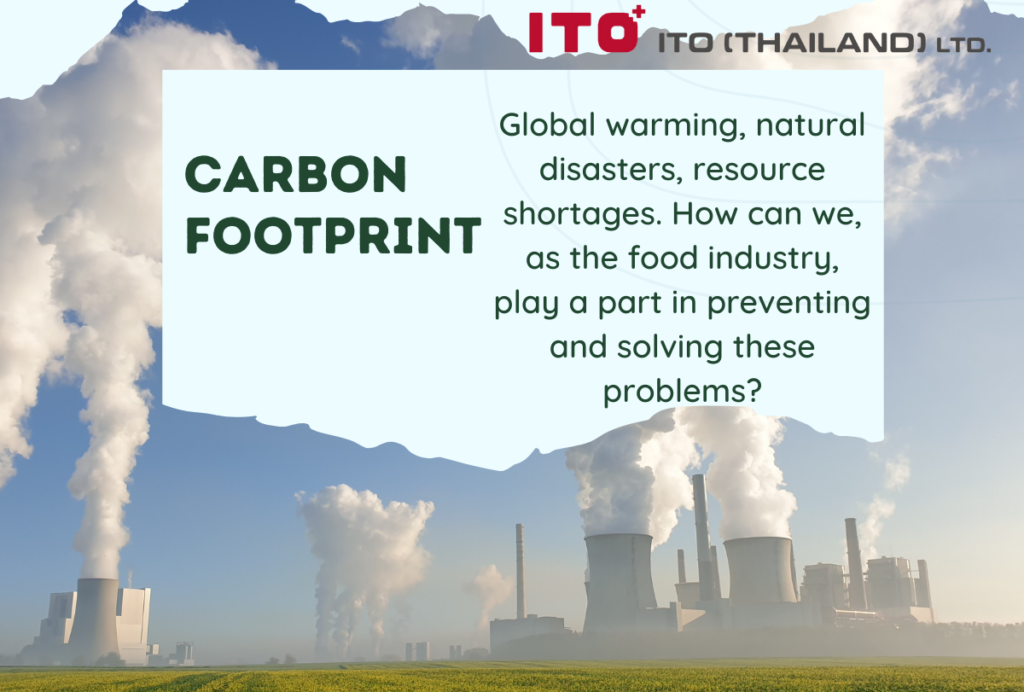ITO Thailand Hygiene Blog
Carbon footprint
Global warming, natural disasters, resource shortages. How can we, as the food industry, play a part in preventing and solving these problems?
At present, one of the reasons for natural changes such as wildfires occurring more frequently, floods, and climate change, including the behaviors of plants and animals, is the rising global average temperature. The polar ice caps are melting more, and the currents, temperature of wind, water, and humidity are changing. One of the main factors contributing to global warming is greenhouse gases such as carbon dioxide, methane, chlorofluorocarbons, and many others, which can absorb and emit thermal radiation back to the surface of the Earth. When these gases become greater in volume, they induce the greenhouse effect that causes the Earth’s surface temperature to rise and affects the behavior of the weather and life on Earth itself.
UNFCCC and the reduction of greenhouse gas emissions
Due to the abovementioned temperature change, the United Nations has organized a negotiating forum to take care of climate problems under the name of the United Nations Framework Convention on Climate Change: UNFCCC to create an agreement among member countries to determine the solution and minimize impacts. The aim is to control the amount of greenhouse gas emissions to slow down the global temperature rise as expressed in the format of carbon footprints.
What is a carbon footprint?
Thailand Greenhouse Gas Management Organization (Public Organization)(1) has defined that [“a carbon footprint” means the number of greenhouse gases emitted from each unit of product throughout the product life cycle; From the acquisition of raw materials, the production process/assembly, distribution, use, and end-of-life waste management, including related transportation. The carbon footprint is calculated in terms of grams, kilograms, or tons of carbon dioxide equivalent]. This means that the carbon footprint reflects the greenhouse gas emissions of that product throughout the supply chain, raw material acquisition, production, and transportation, to waste management. Nowadays, it represents the organization’s stance and informs consumers on product sustainability and enhances global competitiveness.
Measures related to carbon footprints
At present, some countries have begun to impose legal measures (2) to meet the target of reducing greenhouse gas emissions. For example, Mexico has measures for trading greenhouse gas emission permits, a law on the use of the MRV (Measurement reporting and verification) system for data collection, reporting, and verification of greenhouse gas emissions, and pollution tax measures. In the UK, measures are in place for the issuance of a greenhouse gas emissions trading system (EU ETS), whereby those with insufficient allowances will have to purchase them from the carbon market, resulting in more carbon credit trading business.
Thailand’s role
Thailand, one of the member countries of the United Nations, has agreed to the Paris Agreement to control the global average temperature to not exceed 2 degrees Celsius by setting a goal to reduce greenhouse gases by 20% by the year 2030 (3). The Cabinet has included a greenhouse gas reduction action plan into 3 levels of plans: The 1st level plan, the national strategy, the 2nd level plan, the master plan under the national strategy and the national economic and social development plan, and the 3rd level plan, the greenhouse gas reduction action plan.
At present, there are measures to reduce greenhouse gases, such as clinker substitution measures, measures to replace/modify refrigerants, and industrial wastewater management measures. The greenhouse gas emission trading system is voluntary by The Thailand Greenhouse Gas Management Organization.
Nowadays, many private companies have begun to see the importance of sustainability and have started adjusting their corporate policies in production to be more sustainable and reduce carbon footprint. Examples are designing products that are more sustainable, have a lower carbon footprint (e.g., change of source of raw materials with shorter transport times, types of raw materials that emit less greenhouse gas, lighter packaging design, stackable, easier to transport. or recyclable), new manufacturing processes that reduce energy consumption or use energy more efficiently, waste reduction, issuing energy-saving policies and marketing policies such as refill stations and packaging returns.
References
1.http://thaicarbonlabel.tgo.or.th/
2.สุปวีณ์ กรดเสือ. 2562. มาตรการทางกฎหมายในการส่งเสริมการลดการปล่อยก๊าซเรือนกระจกจากโรงไฟฟ้าพลังความร้อน.วารสารนิติ รัฐกิจ และสังคมศาสตร์ ปีที่ 3 ฉบับที่ 1
3.https://climate.onep.go.th/wp-content/uploads/2021/09/NDC_Action_Plan_IPPUInd-WW_sector.pdf
Related Post
-

Food Safety Culture
Food safety culture plays a crucial role in safeguarding the company's reputation, ensuring the well-being of its employees, and providing a safe experience for its customers.
-

New food source safety issues
What are safety issues worth knowing for trendy new food sources like plant-based and insect-based proteins?
-

British Retail Consortium (BRC) Standard
Food safety management systems play a vital role in ensuring the production and distribution of safe and high-quality food products to consumers. With the global food supply chain becoming increasingly complex, food businesses must implement effective systems prioritising safety, quality, and compliance with industry standards. A food safety management system encompasses a set of procedures, processes, and controls designed to identify, prevent, and manage potential hazards at every stage of the food production and supply process. This proactive approach not only safeguards consumers' health but also protects the reputation and credibility of food companies in an ever more competitive market.
-

Food Science in the World of Food Gastronomy (Part 1)
How can food science be applied to create new dishes?
-

FSSC 22000
Food manufacturers must ensure food safety standards and processes. FSSC 22000 is an official certification program for Food Safety Management Systems (FSMS) recognised by the Global Food Safety Initiative (GFSI). This certification scheme offers a set of guidelines and procedures to ensure uniformity, openness, and safety across your entire supply chain. It applies to all companies operating within the food and beverage industry, ranging from farmers to retailers. By fulfilling the necessary criteria and obtaining FSSC 22000 certification, it is demonstrated that the required standards for food quality and implementing effective processes to manage and mitigate risks associated with food fraud, foodborne illnesses, expensive recalls, and other external threats are met.
-

Food Safety Aspects of Artificial Sweeteners
Artificial sweeteners, also known as sugar substitutes, non-nutritive sweeteners, or high-intensity sweeteners, are artificially produced compounds utilised in place of sucrose (table sugar) to add sweetness to food and drinks. Due to their significantly higher sweetness than regular sugar, only a fraction of artificial sweeteners (200 to 20,000 times less) is required to achieve an equivalent level of sweetness. Since the caloric contribution of these sweeteners, when used in such small quantities, is insignificant, they are often referred to as non-nutritive (4).










